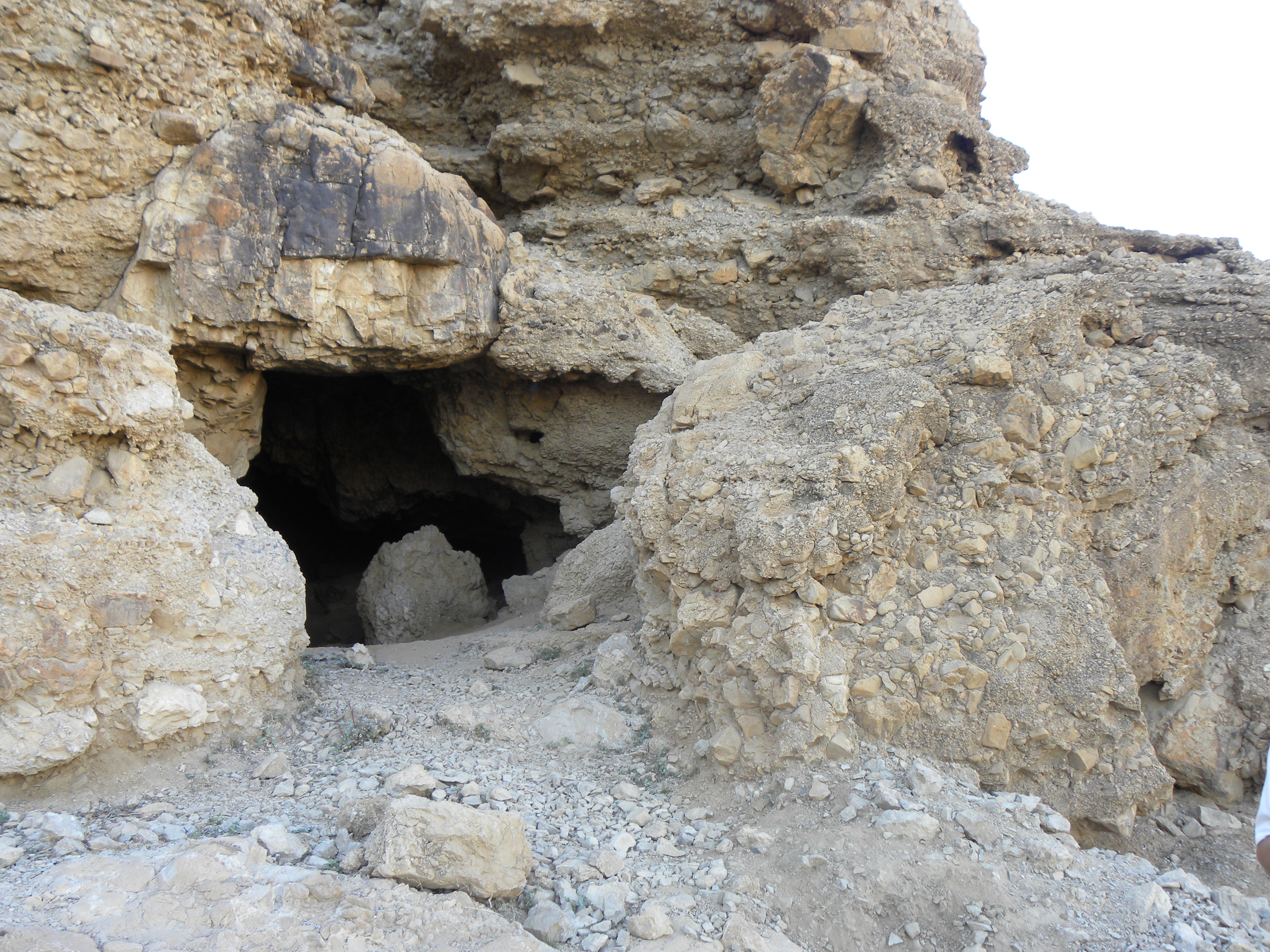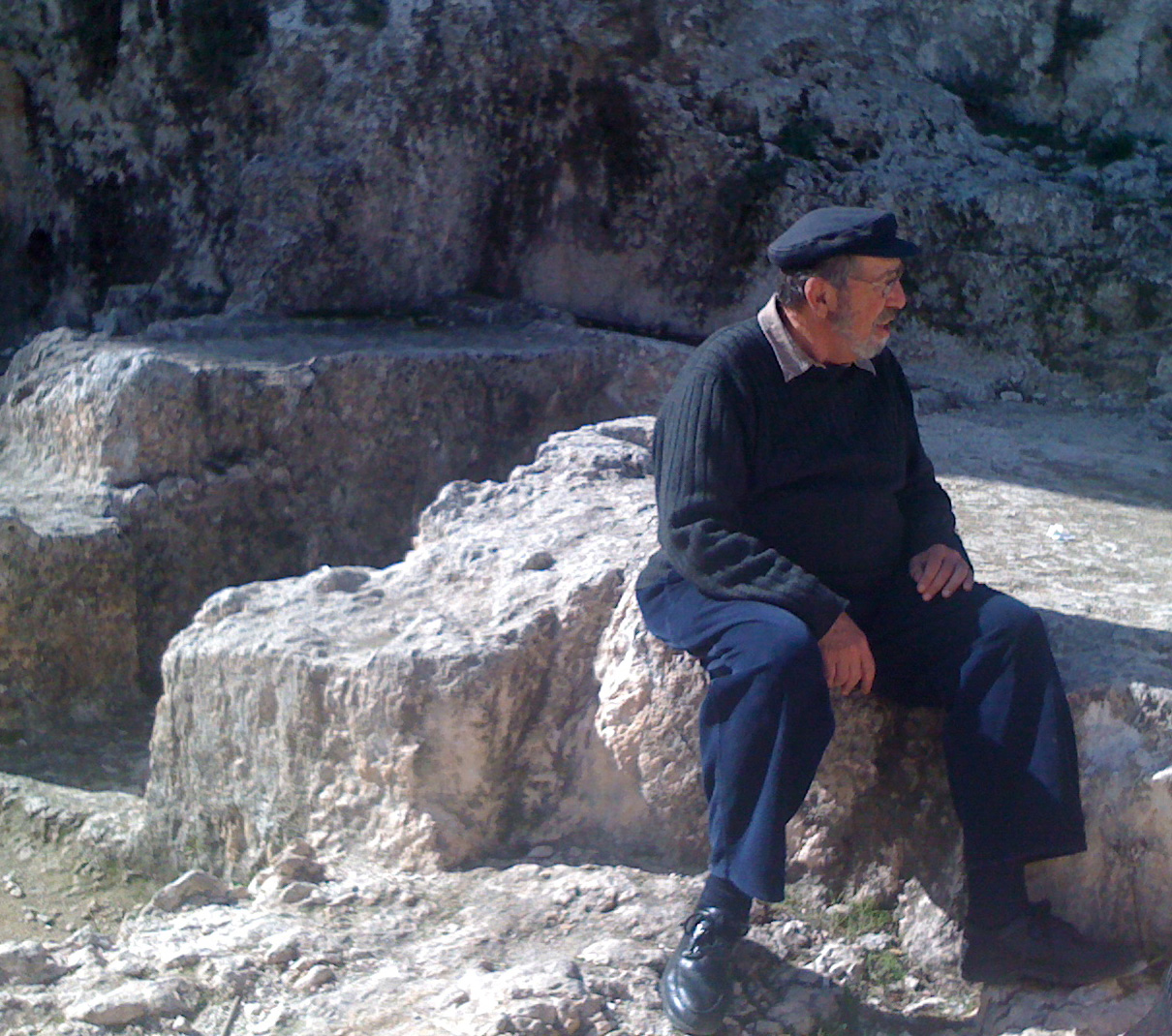|
11QpaleoLev
Paleo-Hebrew Leviticus Scroll, known also as 11QpaleoLev, is an ancient text preserved in one of the Qumran group of caves, which provides a rare glimpse of the script used formerly by the Israelites in writing Torah scrolls during pre- exilic history. The fragmentary remains of the Torah scroll is written in the Paleo-Hebrew script and was found stashed away in cave no. 11 at Qumran, showing a portion of Leviticus. The scroll is thought to have been penned by the scribe between the late 2nd century BCE to early 1st century BCE, while others place its writing in the 1st century CE. The paleo-Hebrew Leviticus Scroll, although many centuries more recent than the well-known earlier ancient paleo-Hebrew epigraphic materials, such as the Royal Steward inscription from Siloam, Jerusalem (8th century BCE), now in the Museum of the Ancient Orient, Istanbul, and the Phoenician inscription on the sarcophagus of King Eshmun-Azar at Sidon, dating to the fifth-fourth century BCE, the Lachis ... [...More Info...] [...Related Items...] OR: [Wikipedia] [Google] [Baidu] |
Paleo-Hebrew
The Paleo-Hebrew script (), also Palaeo-Hebrew, Proto-Hebrew or Old Hebrew, is the writing system found in Canaanite and Aramaic inscriptions, including pre-Biblical and Biblical Hebrew, from southern Canaan, also known as the biblical kingdoms of Kingdom of Israel (Samaria), Israel (Samaria) and kingdom of Judah, Judah. It is considered to be the script used to record the original texts of the Bible due to its similarity to the Samaritan script; the Talmud states that the Samaritans still used this script.Sanhedrin (tractate), Sanhedrin 21b:22: " Mar Zutra says, and some say that it is Mar Ukva who says: Initially, the Torah was given to the Jewish people in Ivrit script, and the sacred tongue, Hebrew. It was given to them again in the days of Ezra in Ktav Ashuri, ''Ashurit'' script and the Jewish Babylonian Aramaic, Aramaic tongue. The Jewish people selected the ''Ashurit'' script and the sacred tongue for the Torah scroll and left the ''Ivrit'' script and the Aramaic tongue for ... [...More Info...] [...Related Items...] OR: [Wikipedia] [Google] [Baidu] |
Paleo-Hebrew Alphabet
The Paleo-Hebrew script (), also Palaeo-Hebrew, Proto-Hebrew or Old Hebrew, is the writing system found in Canaanite and Aramaic inscriptions, including pre-Biblical and Biblical Hebrew, from southern Canaan, also known as the biblical kingdoms of Israel (Samaria) and Judah. It is considered to be the script used to record the original texts of the Bible due to its similarity to the Samaritan script; the Talmud states that the Samaritans still used this script.Sanhedrin 21b:22: " Mar Zutra says, and some say that it is Mar Ukva who says: Initially, the Torah was given to the Jewish people in Ivrit script, and the sacred tongue, Hebrew. It was given to them again in the days of Ezra in ''Ashurit'' script and the Aramaic tongue. The Jewish people selected the ''Ashurit'' script and the sacred tongue for the Torah scroll and left the ''Ivrit'' script and the Aramaic tongue for the commoners. Who are these commoners? Rav Chisda said: The Samaritans utim What is ''Ivrit'' scrip ... [...More Info...] [...Related Items...] OR: [Wikipedia] [Google] [Baidu] |
Israel Antiquities Authority
The Israel Antiquities Authority (IAA, ; , before 1990, the Israel Department of Antiquities) is an independent Israeli governmental authority responsible for enforcing the 1978 Law of Antiquities. The IAA regulates excavation and conservation, and promotes research. The Director-General is Eli Escusido - sometimes written Eskosido. The Jay and Jeanie Schottenstein National Campus for the Archaeology of Israel is the new home of the IAA, located on Museum Hill, in the heart of Jerusalem, capital of the State of Israel,.The campus is planned on 20,000 square meters between the Israel Museum and the Bible Lands Museum by Architect Moshe Safdie. The aim of the National Campus is to exhibit approximately two million ancient artifacts and make them accessible to the public. The National Campus serves as a center for research, education, demonstration, display, and explanation of Israel's cultural heritage across its various cultural and religious spectrums, throughout human ... [...More Info...] [...Related Items...] OR: [Wikipedia] [Google] [Baidu] |
Ktav Ashuri
''Ktav Ashuri'' (, ', lit. "Assyrian Writing") also ''(Ktav) Ashurit'', is the traditional Hebrew language name of the Hebrew alphabet, used to write both Hebrew and Jewish Babylonian Aramaic. It is often referred to as (the) Square script. The names "''Ashuri''" ( Assyrian) or "''square script''" are used to distinguish it from the Paleo-Hebrew script. According to Halakha (Jewish religious law), tefillin (phylacteries) and mezuzot (door-post scripts) can only be written in Ashurit. Name ''Ktav Ashuri'' is the term used in the Talmud; the modern Hebrew term for the Hebrew alphabet is simply "Alphabet Hebrew". Consequently, the term ''Ktav Ashuri'' refers primarily to a traditional calligraphic form of the alphabet used in writing the Torah., s.v. ''Megillah'' 1:8, p. 202note 20; '' Yadayim'' 4:5-6,note 6 However, the term ''Ashuri'' is often used in the Babylonian Talmud to refer to the contemporary "Hebrew alphabet", as opposed to the older Paleo-Hebrew script. The T ... [...More Info...] [...Related Items...] OR: [Wikipedia] [Google] [Baidu] |
Mar Ukva
Mar Ukva Mar Ukva , מר עוקבא Sages of the Talmud (or Mar Ukba; other: Mar Ukva (I); also identified with Nathan de-zuzita) was an '' Amora'' of , of the first generation of the Amora era. Biography He served as an during the days of , who was also his Rabbi, but at the same time, Samuel was subor ...[...More Info...] [...Related Items...] OR: [Wikipedia] [Google] [Baidu] |
Mar Zutra
Mar Zutra (, died 417 CE) was a Babylonian rabbi, of the sixth generation of amoraim. Biography He was a student of Rav Papa, whom he frequently quoted, and Rav Papi. His closest colleagues were Rav Ashi and Amemar. The three of them are described together in their studies, meals, and visits to the court of Yazdegerd I.Ketuvot 63b; Brachot 44b, 50b; Pesachim 103b; Ketuvot 61a He headed the Yeshiva of Pumbedita, and according to the book "Seder Tannaim ve-Amoraim", previous to Rav Aha b. Rava. In the ''Iggeret Rav Sherira Gaon'' (French version), he is not mentioned as a head of a Yeshiva A yeshiva (; ; pl. , or ) is a traditional Jewish educational institution focused on the study of Rabbinic literature, primarily the Talmud and halacha (Jewish law), while Torah and Jewish philosophy are studied in parallel. The stu ..., but in later sources he is noted as Mar Zutra, Head of a Yeshiva. References Talmud rabbis of Babylonia Rabbis of Academy of Pumbedi ... [...More Info...] [...Related Items...] OR: [Wikipedia] [Google] [Baidu] |
Sanhedrin (tractate)
''Sanhedrin'' () is one of ten tractates of Seder Nezikin (a section of the Talmud that deals with damages, i.e. civil and criminal proceedings). It originally formed one tractate with Makkot, which also deals with criminal law. The Gemara of the tractate is noteworthy as precursors to the development of common law principles, for example the presumption of innocence and the rule that a criminal conviction requires the concurrence of twelve. Summary of Sanhedrin Within Seder Nezikin, the Sanhedrin focuses on questions of jurisdiction, criminal law and punishments. The tractate includes eleven chapters, addressing the following topics: # The different levels of courts and which cases each level presides over # Laws of the high priest and Jewish king and their involvement in court proceedings # Civil suits: acceptable witnesses and judges and the general proceedings # The difference between criminal and civil cases, general proceedings in criminal cases # Court procedures, includ ... [...More Info...] [...Related Items...] OR: [Wikipedia] [Google] [Baidu] |
Hasmonean Dynasty
The Hasmonean dynasty (; ''Ḥašmōnāʾīm''; ) was a ruling dynasty of Judea and surrounding regions during the Hellenistic times of the Second Temple period (part of classical antiquity), from BC to 37 BC. Between and BC the dynasty ruled Judea semi-autonomously within the Seleucid Empire, and from roughly 110 BC, with the empire disintegrating, gained further autonomy and expanded into the neighboring regions of Perea, Samaria, Idumea, Galilee, and Iturea. The Hasmonean rulers took the Greek title ''basileus'' ("king") and the kingdom attained regional power status for several decades. Forces of the Roman Republic intervened in the Hasmonean Civil War in 63 BC, turning the kingdom into a client state and marking an irreversible decline of Hasmonean power; Herod the Great displaced the last reigning Hasmonean client-ruler in 37 BC. Simon Thassi established the dynasty in 141 BC, two decades after his brother Judas Maccabeus ( ''Yehudah HaMakabi'') had defeated the ... [...More Info...] [...Related Items...] OR: [Wikipedia] [Google] [Baidu] |
Ketef Hinnom Scrolls
The Ketef Hinnom scrolls, also described as Ketef Hinnom amulets, are the oldest surviving texts currently known from the Hebrew Bible, dated to 600 BCE. The text, written in the Paleo-Hebrew script (not the Babylonian square letters Hebrew alphabet, of the modern Hebrew alphabet, more familiar to most modern readers), is at least partially from the Book of Numbers in the Hebrew Bible, and has been described as "one of the most significant discoveries ever made" for biblical studies. The two silver scrolls were uncovered in 1979 at Ketef Hinnom, an archaeological site southwest of the Old City of Jerusalem, and were found to contain a variation of the Priestly Blessing, found in (see also Mechon-Mamre). The scrolls were dated Paleography, paleographically to the late 7th or early 6th century BCE, placing them in the Solomon's Temple, First Temple period. Discovery The scrolls were found in 1979 in Chamber 25 of Cave 24 at Ketef Hinnom, during excavations conducted by a team unde ... [...More Info...] [...Related Items...] OR: [Wikipedia] [Google] [Baidu] |
History Of The Hebrew Alphabet
The Hebrew alphabet is a script that was derived from the Aramaic alphabet during the Achaemenid Empire, Persian, Seleucid Empire, Hellenistic and Hasmonean_dynasty, Roman periods ( – 50 CE). It replaced the Paleo-Hebrew alphabet which was used in the earliest epigraphic records of the Hebrew language. History file:CursiveWritingHebrew.png, left, 100px, Variations of the "square" Hebrew script by region and time The history of the Hebrew alphabet is not to be confused with the history of the Paleo-Hebrew alphabet, so called not because it is ancestral to the Hebrew '' alphabet'' but because it was used to write the earliest form of the Hebrew language, Hebrew ''language''. "Paleo-Hebrew alphabet" is the modern term (coined by Solomon Birnbaum in 1954) used for the script otherwise known as the Phoenician alphabet when used to write Hebrew, or when found in the context of the ancient Israelite kingdoms. This script was used in the kingdoms of Israel and Judah as well as through ... [...More Info...] [...Related Items...] OR: [Wikipedia] [Google] [Baidu] |
David Noel Freedman
David Noel Freedman (12 May 1922 – 8 April 2008) was an American biblical scholar, author, editor, archaeologist, and, after his conversion from Judaism, a Presbyterian minister. He was one of the first Americans to work on the Dead Sea Scrolls. He is the son of the writer David Freedman. He died of a heart ailment. Life Freedman was born Noel Freedman in New York City on May 12, 1922, the son of David and Beatrice Freedman. The elder Freedman died in 1936 and Noel adopted his name as a mark of respect. Soon after, he converted to Christianity and became a member of the Presbyterian Church. ''The New York Times'' misidentified Noel as a girl in David Freedman's obituary. He attended the City College of New York and he earned his B.A., after which he entered Princeton Theological Seminary, where he earned a Bachelor of Theology degree in 1944. He then went on to study Semitic Languages and Literature at The Johns Hopkins University. In 1947, while he was still a graduate stud ... [...More Info...] [...Related Items...] OR: [Wikipedia] [Google] [Baidu] |






